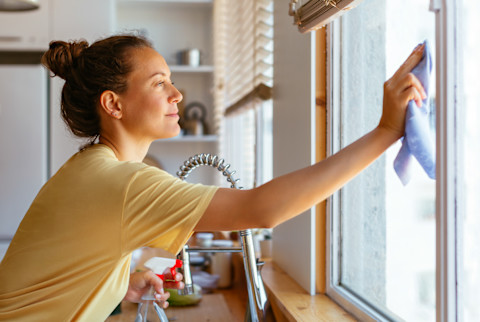The Part Of Your Home That's Most Likely To Have Mold (And How To Clean It)

Spring is officially here, and for many, that means it's time to don our gloves and grab the cleaning supplies. Spring cleaning shouldn't just involve scrubbing every nook and cranny, though. To ensure a clean and safe home, we should also add "look for mold" to our seasonal checklist. As for the one place you should always inspect first, it's got to be the bathroom.
Why the bathroom?
Mold spores need two main components for growth: food and moisture. When it comes to our bathrooms, both of these can be in abundance if we don't take steps to remove them. These rooms can have plenty of food options for mold in the form of dust, skin cells, and other organic particles. As for moisture, between the shower, tub, sink, and toilet, water abounds in bathrooms too.
Given these two elements, a mold spore can begin growing in as little as 24 to 48 hours. Once a colony is established, it can begin releasing spores throughout the space, creating poor indoor air quality and contaminating surfaces. It also increases the chances of additional mold problems developing throughout the room. One mold problem can quickly and easily turn into four or five.
By taking a close look and inspecting the space during spring cleaning, we can ensure our bathrooms remain safe havens.
The top places to look for mold in the bathroom.
Specific places in the bathroom are highly prone to mold growth. These are the three areas you should prioritize during your inspection:
In the toilet tank.
This is one of my favorite tricks to recommend when it comes to checking for mold, and it only takes 30 seconds. All you have to do is walk up to that porcelain throne, lift the lid, and take a look inside the tank and at the interior of the lid itself. If there's mold, it could indicate a larger problem elsewhere in the house.
When it comes to the toilet tank, the lid is heavy, but it's not hermetically sealed. That's pretty much a fancy way of saying that it doesn't allow for much air exchange. If mold starts growing inside of the tank, that typically means there are enough spores in the air that some were opportunistically able to get into this location. It's not impossible for a lucky spore to make it inside of the toilet, but it's far more likely that a mold colony elsewhere is pumping spores into the indoor air of the home.
Under the sink.
We don't often get up close and personal with the underneath of our sinks—so if a small leak were to occur, mold could grow there for some time before being discovered. Some mold goes unnoticed for years, allowing the problem to grow, spread throughout the home, and potentially affect the health of those exposed.
To avoid this, grab a flashlight and take a close look at the entire space underneath the sink or sinks in the bathroom. Look for current mold growth and potential issues that could lead to growth, like worn or leaking pipes.
On the tub/shower grout.
Grout can easily become a home for mold. As grout becomes semi-porous over time, organic particles and water can make their way inside, creating the perfect environment for the fungus among us to grow. Sometimes, that mold can end up spreading its roots all the way to the wall behind the grout as well, creating an even bigger contamination issue.
While deep-diving into bathroom(s) cleaning, take a close look at the grout in the tub or shower to see if there are any signs of mold. Also, check for any issues that could lead to growth. Misaligned tiles, aged grout, lack of cleaning, and poor grouting practices can all allow for moldy opportunities.
What to do if you find mold.
If you discover mold during your search and it's a small enough problem (meaning it's in a small patch on a hard, nonporous surfaces like metal or glass), it can be tackled while spring cleaning. Make sure to put on protective gear like gloves and a face mask, though. Direct exposure to this indoor contaminant as well as to the particles kicked up into the air during remediation can trigger adverse health reactions.
Simply spray a disinfectant cleaner1 (I personally recommend Benefect Decon 30) on a microfiber towel and wipe away the mold. For the toilet specifically, turn the water off, flush the toilet a few times, and use a spray bottle to coat the entire interior (including the lid) with the cleaning product. Allow this to sit for a few minutes before wiping it away with the microfiber towel.
For semi-porous surfaces like grout, use 8% hydrogen peroxide and a microfiber towel. (Again, be sure to wear gear for this!) Spray the hydrogen peroxide on all of the grout in the tub or shower, and let it sit for at least 10 minutes. Then, wipe with a microfiber towel.
If the mold comes right back, it could indicate a larger issue that requires a professional. Hiring a mold inspector to come in can help determine if there's a hidden problem elsewhere.
The bottom line.
Inspecting bathrooms during your spring cleaning is a great way to ensure these rooms are safe and contaminant-free, and it's good practice to keep up with throughout the year. The more indoor mold growth we can avoid, the healthier our living spaces will be, and the more they'll promote our ongoing well-being.
